
Topics
Guests
- Nomi Prinsformer investment banker turned journalist. She worked at Goldman Sachs and Bear Stearns. She is the author of several books; her latest, just out, is called It Takes a Pillage: Behind the Bonuses, Bailouts, and Backroom Deals from Washington to Wall Street. Her latest article is titled 'Obama Banking Too Much on Banks'
President Obama visited Wall Street Monday to promote a regulatory overhaul of the US financial system. The visit came on the one-year anniversary of the collapse of the investment bank Lehman Brothers. Lehman’s bankruptcy set off a series of events across the financial markets, leading to a full-scale economic meltdown. Speaking at Federal Hall, Obama promoted Democratic proposals for new financial oversight and a consumer protection agency to protect Americans from unfair loans, but Nomi Prins, an investment banker turned journalist, says Obama’s proposed reforms don’t go deep enough. [includes rush transcript]
Transcript
SHARIF ABDEL KOUDDOUS: President Obama visited Wall Street Monday to promote a regulatory overhaul of the US financial system. The visit came on the one-year anniversary of the collapse of the investment bank Lehman Brothers. Lehman’s bankruptcy set off a series of events across the financial markets, leading to a full-scale economic meltdown.
Speaking at Federal Hall, Obama touted the federal government response in the year since, including the massive Wall Street bailout. He also promoted Democratic proposals for new financial oversight and a consumer protection agency to protect Americans from unfair loans. In some of his most pointed criticism of Wall Street to date, Obama said “reckless behavior and unchecked excess” was “at the heart of the crisis.”
PRESIDENT BARACK OBAMA: While full recovery of the financial system will take a great deal more time and work, the growing stability resulting from these interventions means we’re beginning to return to normalcy. But here’s what I want to emphasize today: normalcy cannot lead to complacency.
Unfortunately, there are some in the financial industry who are misreading this moment. Instead of learning the lessons of Lehman and the crisis from which we’re still recovering, they’re choosing to ignore those lessons. I’m convinced they do so not just at their own peril, but at our nation’s. So I want everybody here to hear my words: we will not go back to the days of reckless behavior and unchecked excess that was at the heart of this crisis, where too many were motivated only by the appetite for quick kills and bloated bonuses. Those on Wall Street cannot resume taking risks without regard for consequences and expect that next time American taxpayers will be there to break their fall.
And that’s why we need strong rules of the road to guard against the kind of systemic risks that we’ve seen. And we have a responsibility to write and enforce these rules to protect consumers of financial products, to protect taxpayers, and to protect our economy as a whole. Yes, there must — these rules must be developed in a way that doesn’t stifle innovation and enterprise. And I want to say very clearly here today, we want to work with the financial industry to achieve that end. But the old ways that led to this crisis cannot stand. And to the extent that some have so readily returned to them underscores the need for change and change now. History cannot be allowed to repeat itself.
SHARIF ABDEL KOUDDOUS: Although Obama had harsh words for Wall Street, he took a softer line in asking for a series of voluntary changes, including overhauling pay structures and subjecting bonuses to a shareholder vote.
PRESIDENT BARACK OBAMA: Here on Wall Street, you have a responsibility. The reforms I’ve laid out will pass, and these changes will become law. But one of the most important ways to rebuild the system stronger than it was before is to rebuild trust stronger than before. And you don’t have to wait for a new law to do that. You don’t have to wait to use plain language in your dealings with consumers. You don’t have to wait for legislation to put the 2009 bonuses of your senior executives up for a shareholder vote. You don’t have to wait for a law to overhaul your pay system so that folks are rewarded for long-term performance instead of short-term gains.
The fact is, many of the firms that are now returning to prosperity owe a debt to the American people. They were not the cause of this crisis, and yet American taxpayers, through their government, had to take extraordinary action to stabilize the financial industry. They shouldered the burden of the bailout, and they are still bearing the burden of the fallout — in lost jobs and lost homes and lost opportunities. It is neither right nor responsible, after you’ve recovered with the help of your government, to shirk your obligation to the goal of wider recovery, a more stable system and a more broadly shared prosperity.
So I want to urge you to demonstrate that you take this obligation to heart; to put greater effort into helping families who need their mortgages modified under my administration’s homeownership plan; to help small business owners who desperately need loans and who are bearing the brunt of the decline in available credit; to help communities that would benefit from the financing you could provide or the community development institutions you could support; to come up with creative approaches to improve financial education and to bring banking to those who live and work entirely outside of the banking system; and, of course, to embrace serious financial reform, not resist it.
AMY GOODMAN: For more on Obama’s speech and the one year since the outbreak of the financial collapse, we are joined by Nomi Prins. She is a former investment banker who worked at Goldman Sachs and Bear Stearns, now a journalist and author of several books, including her latest, just out, It Takes a Pillage: Behind the Bonuses, Bailouts, and Backroom Deals from Washington to Wall Street. Her latest article, posted on the Mother Jones website, is called “Obama Banking Too Much on Banks.” She joins us from Los Angeles today.
Welcome to Democracy Now!, Nomi. Well, let’s start with that title. Why “Banking Too Much on Banks”?
NOMI PRINS: Well, most of what Obama was saying to the Wall Street leaders who were in that room was kind of help us do what we need to do. You know, you cut down your bonuses, you take care of helping homeowners renegotiate their mortgages. Kind of, we’re not going to make you do it. We will probably pass few reforms that will do something to that effect, but, you know, could you guys help us out restrain you?
And just that very notion and the notion that because Wall Street is healthier than it was last year after receiving something like $17.5 billion worth of guarantees, of cheap loans, of other kinds of subsidies, of backup for in case they lose money again, the fact that they’ve returned to some kind of health and normalcy, as Obama put it, rather than looking at what Main Street is actually going through and how it has declined in terms of its own economic health, really just places the emphasis on the wrong group of people.
SHARIF ABDEL KOUDDOUS: And what about the issue of these big banks becoming even bigger? Part of the reason for the bailout was, we were told, they were too big to fail; if they failed, it would cause a systemic collapse of the financial system. Now, a year later after this, many of these big banks are even bigger, and if the risk taking is left unchecked, doesn’t that set us up for a bigger fall?
NOMI PRINS: Absolutely. This time the bigger fall will have been federally funded and federally invoked, because, yes, for one thing, the bigger banks are bigger.
JPMorgan Chase was given Bear Stearns and Washington Mutual, with some padding from the US government in terms of guaranteeing additional losses that it might incur from acquiring those companies. It became bigger.
Wells Fargo-Wachovia became bigger. Wachovia was run for a little bit by a former Goldman executive. It became bigger under a Fed and Treasury decision, although it’s ultimately the Fed’s decision to push mergers.
Bank of America-Merrill Lynch, bigger. That is a risky, risky institution. Merrill Lynch was on the brink of failure; it was about to become a Lehman Brothers, and the choice was to give it to Bank of America and make the combined entity bigger.
So now we have three banks that actually push outside of the ten percent limit laws that the FDIC is supposed to enforce and has in place to restrict the amount of deposits, consumer deposits, they can hold. They are all at or above the limits. And they were put there by the federal government.
SHARIF ABDEL KOUDDOUS: And what about the issue of Wall Street compensation? We saw earlier this year an uproar over the bonuses at AIG. Goldman Sachs this year is on track, on average, per employee, to earn $700,000, on average. It does not seem that compensation has been curtailed at all.
NOMI PRINS: No. In fact, compensation is actually running ahead of what it was in 2007. So not only has it not been curtailed at a place like Goldman Sachs, it’s actually on track to be more than it was before the crisis. So the idea that there’s going to be any sort of constraint or restraint coming from inside the meeting rooms where bonuses are fought for and discussed really every day of the year after every big trade that happens is just ludicrous.
AMY GOODMAN: Just following up on that point, a headline that we just read about the bank — the court that challenged the bonuses, can you talk about the significance of that?
NOMI PRINS: Well, I’m actually really glad you brought up that point, because I thought it was insane that the SEC agreed to a $33.5 million settlement on a $3.6 billion bonus misrepresentation, when the federal government backed the acquisition of Merrill Lynch by Bank of America at the end of last year that took effect on January of this year. The fact that there was even a settlement to begin with, so quick and so cheap, was absolutely insane. So Judge Rakoff absolutely did the right thing to say, wait a minute, this is not moral, this isn’t just, this isn’t right.
We’ve paid money to have that merger happen. And you know what? We are still paying money to float the risk that that merger has incurred. We are still paying money into Bank of America. It still has a lot of taxpayer money, almost $118 billion that is on record, and more in loans from the Fed that the Fed refuses to disclose the exact nature of.
And that fact that the SEC, under President Obama, made the decision to allow a sort of little wrist slap for that behavior was wrong to begin with. So I hope this will be looked into further. I don’t know that it will change the bonus structure on Wall Street in general. Again, that fight for bonuses goes on all the time, and bonuses are collectively more. But it is good that that decision was made.
SHARIF ABDEL KOUDDOUS: The total level of the bailout, in your article, you put that figure at over $19 trillion, over $17 [trillion] of which went to the financial industry. How did you come up with this number? We’ve heard it reported much less.
NOMI PRINS: Well, I actually also reported it as less not too long ago. That number is compiled. And I run the reports on a regular updated basis on my website. It is compiled out of all publicly available information, from releases from the FDIC, from going into their databases, which anyone can do — you just kind of have to tinker to find how banks are doing and what they’ve gotten in terms of FDIC guarantees for their debt — looking at the Fed’s balance sheet, looking at the language — and some of it’s very convoluted — of what comes out of the Treasury when they change programs and enhance programs that have already been given to the banks, that don’t tend to get headline news when they happen. So it’s really kind of digging and scratching into what is publicly available and changes publicly, but not openly, to try and compile a picture of where the ballot has been.
And I do break it down then into what’s come out of the Fed, which is about $8 trillion of that; what’s come out of the Treasury Department, which is around $5.5 trillion; another almost $2 [trillion] from the FDIC; more in terms of joint efforts by all three that are a little harder to figure out who’s getting what risk and who’s paying what to the industry, and compile it that way. And that $17.5 trillion, that also includes a recent addition, which is $3.5 trillion to back money market funds. Recall, those were having deep problems at the end of last year and throughout the fall. They’re not having as many problems now, but there was still a choice made between the Treasury Department and the — excuse me — the FDIC to enhance the guarantees in case those fall apart again.
So, some of the money has been given direct; some of the money is on loan from the Fed, where we don’t have all of the details; and some of it’s kind of there as deep backup in case things go really south again for the banking industry. And then a small portion of that actually has been given to consumers in some way, through the fiscal stimulus package, through the Recovery Act, through some tax incentives to first-time home buyers, and through the cash-for-clunkers program. So there is a small portion, less than nine percent, that’s kind of been given to individuals, but the rest of it, the other 91 percent, has been given to Wall Street or to the markets in general.
AMY GOODMAN: Nomi, what about the proposal for a consumer financial protection agency and the Chamber of Commerce launching a multi-million-dollar campaign to kill it, the agency that would monitor the products that banks and institutions sell to consumers, including subprime loans?
NOMI PRINS: Well, exactly. Obviously, the Wall Street lobbies and the Chamber of Commerce have gotten together, because this is the one thing they fear, that the business that they do is somehow going to be hampered, that the next time they come up with something creative, which tends to mean obtuse, won’t be able to be produced for their customers, they won’t be able to make money off it.
And the reason they’re also so scared goes to why a lot of this crisis happened. It wasn’t necessarily because of the subprime loans and those foreclosures and those defaults. It was because the banking industry packaged and repackaged and borrowed against and created this whole mass pyramid of risk on top of these little layer of loans, and that’s the problem. And they don’t want that layer to go away, because they cannot build up the risk and the debt above what’s not there. And that’s why they are scared.
So we definitely need a strong consumer financial protection agency, not in name, not as another regulatory body going through reports, but legitimately able to restrain the types of risks that are in products so that consumers do not get hurt by using products that ultimately are leveraged to the hilt and cause the risk and chaos to the general financial system that Wall Street created from them. So, to be really effective, I hope that the consumer financial protection agency does get created and does have the power to both help consumers and to get in the way — and that’s the thing that scares Wall Street the most, so you know it’s the right thing to do — to get in the way of packaging things and creating risk on top of consumers, as well, because that decays the entire system, as well as hurts consumers.
SHARIF ABDEL KOUDDOUS: And finally, Nomi Prins, your new book, It Takes a Pillage, talk about the premise of what the book is and also this issue of real reform. You call for a return to the Glass-Steagall Act, bringing that back?
NOMI PRINS: Well, exactly. We’re not talking about true reform right now. When I wrote the book, it was just as — after the financial crisis had been developing after the fall. And because I had no idea originally where all the bailout money was coming from, which entities in Washington, where it was going, what conversations were happening in terms of making all of those decisions, and by whom. So the book is really about tracking what truly went on; who said what to whom; how, for example, the meetings between Treasury Secretary Hank Paulson, who was a former CEO of Goldman Sachs, and the current CEO of Goldman Goldman Sachs, Lloyd Blankfein, went down; how the meetings between the current CEO of JPMorgan Chase, Jamie Dimon, and the other powers that be in Washington went down, when his piece of the banking pie was reconstructed, and all of that; how we wound up paying for that, not just in actual direct money, which we did, but also in all the loans and guarantees and debt to the system, that only — only serve to create a status quo situation that will potentially devolve into more risk, but on our money.
It used to be that the banking system floated on its own investments and raising its own capital and using, unfortunately, our loans and our credit products to borrow against and leverage up against and create more risk. Now they’re using the government’s money. So now we’re in a far worse situation. I thought it was really important to explain exactly why that is. And the bailout was never about the little guy and never about the subprime mortgage; it was about so much more.
And in terms of reform, I absolutely think we need to return to Glass-Steagall. That was a time, in 1933, when Wall Street had really wrecked the rest of the economy, where the same types of practices, actually, that we now know today — the risk, the selling securities based on other little loans that don’t have as much value as they say they have, and all of that — that was happening in 1929. It was just with different stuff. It’s the same process. And in 1933, the decision by Congress, by FDR, who was a Democratic president, by a Treasury secretary that was a Republican, was that the banks should be divided into two components: a commercial bank that dealt with deposits and consumers and checking accounts and, you know, regular loans; and the risky investment bank and trading entities that could do whatever they wanted to do, but they didn’t get the government’s backing and the government’s help and the government guarantees to go and do it.
And that distinction, had we had that, would have saved us a lot of money. It also would have made sure that we don’t have banks trading on the back of consumer loans and therefore giving the incentive to screw around with consumer loans and to make them so nontransparent, because that is how they are most profitable when they get packaged up.
And so, dividing the landscape like was done then also allowed the regulatory agency at the time, the FDIC, to do its job better, to back deposits better. Now it keeps running out of money and asking Congress for more, because it’s supposed to back banks that have taken on all these other risks that have nothing to do with consumer deposits. And so, dividing the landscape really is the only way to bring stability, to really rein in Wall Street, not to ask them if it’s OK, but to just go ahead and do it. It will be cheaper for the country. It’ll be more stable for the economy. It will make more sense, actually, for the banking system.
AMY GOODMAN: Nomi Prins, we want to thank you for being with us. Former investment banker turned journalist, she worked at Goldman Sachs and Bear Stearns, author of a number of books. Her newest is just out; it’s called It Takes a Pillage: Behind the Bonuses, Bailouts, and Backroom Deals from Washington to Wall Street.

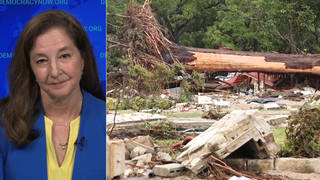
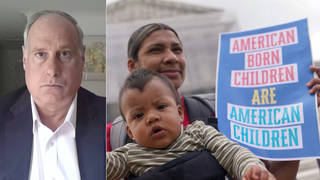
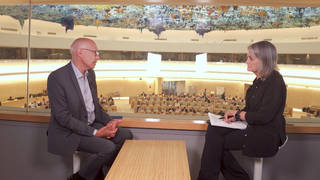

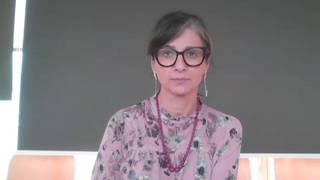
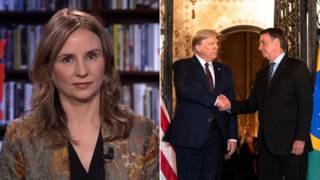
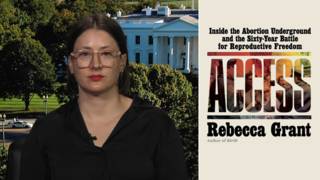

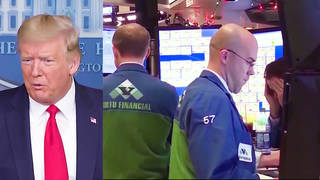

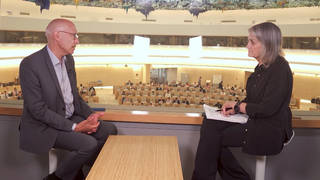
Media Options